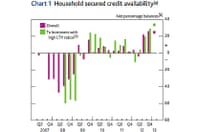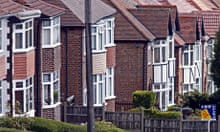House prices fell by 0.1% in December and ended 2012 down by 1%, according to figures from Nationwide building society.
The lender's monthly snapshot of the housing market showed the annual rate of movement remained in negative territory for the 10th month in succession, and the 1% drop over the year reversed the 1% rise seen in 2011.
The average price of a home in the UK in December was £162,262, based on Nationwide's data for mortgages that have been valued and approved.
Its chief economist, Robert Gardner, said that given the UK was in recession for much of 2012 the figures could suggest the housing market had put in a "relatively resilient performance".
However, he said conditions remained fragile, with potential buyers still deterred by problems in the wider economy and affordability issues. House prices are still around 5.1 times earnings against a long-term average of 4.2 times.
"The outlook remains uncertain," he said. "Continued low interest rates and policy measures such as the Funding for Lending scheme should provide some support.
"But, with the economic recovery expected to remain fairly weak, the market is likely to be characterised by low levels of activity again in 2013, with prices remaining flat or modestly lower over the course of the year."
The society's quarterly regional data underscored the variations around the UK. While house prices in Northern Ireland fell by 8.2% over the year, ending 2012 more than 50% below their 2007 levels, in England they recorded a drop of just 0.4%. Wales saw a 2.7% fall while in Scotland it was 3.3%.
Within England, the north-south divide widened to the highest level yet, with the price of a typical home in the south now about £95,000 more than in the north.
According to the society, the average price of a home across the north of England, Yorkshire & Humberside, the north-west and the east and West Midlands was £133,778, versus an average of £228,257 across East Anglia, the south-east, London and the south-west.
The London market was a key factor in the rise in prices across England, up 0.7% between the final quarter of 2011 and the corresponding period in 2012, the largest regional increase recorded by the lender. In Southwark, prices rose by 11% year-on-year.
The cities with the biggest increases were Cambridge, up by 6% at £336,667, and Coventry, up 3% at £165,100; the biggest fallers were Bradford and Manchester, both down by 9% to £145,478 and £171,830 respectively.
Henry Pryor, a buying agent and housing market commentator, said mortgage lenders' figures only told part of the story.
"We believe that close to half of all transactions in 2012 were 'cash' deals involving no mortgage finance, so it's much harder for mortgage lenders to see as much of the market as they perhaps once did," he said.
"As we saw over Christmas, the Halifax pronounced that prices in Southend in Essex had risen by 15% over 2012, but when the Land Registry published their numbers yesterday they confirmed a much more modest rise of just 3.9%."
Pryor added: "It would be unfair to accuse mortgage lenders of talking up their own book, but just as no one likes a cheerful undertaker, whistling as he goes about his work, no one wants to borrow money from a lender who suggests house prices tomorrow will be cheaper than they are today."
The most recent Land Registry figures for the whole of the UK showed a similar annual fall in the year to November as that recorded by Nationwide's index.
Economists said they expected a similar flatlining of prices in 2013.
Howard Archer, chief UK economist at IHS Global Insight, said greater availability of mortgages through the government's Funding for Lending scheme meant house prices were likely to be "broadly flat" in 2013.
"We suspect that any significant, sustainable turnaround in house prices is still some way off, and is unlikely to occur in 2013," he said.




Comments (…)
Sign in or create your Guardian account to join the discussion